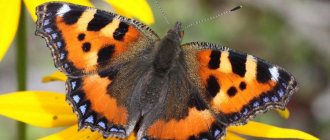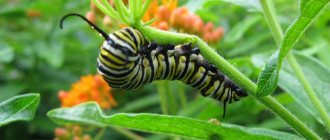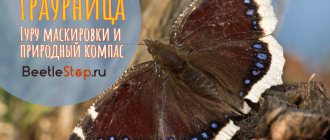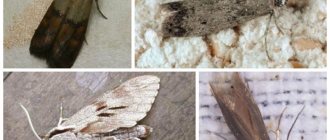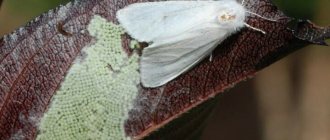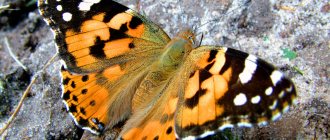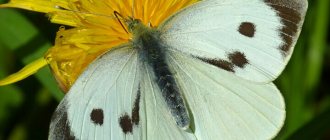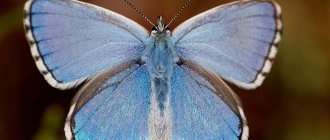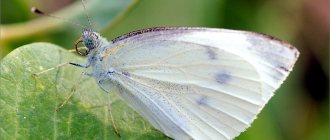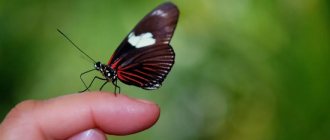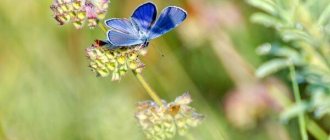- Lifespan
And this is true; in the amazingly diverse world of insects, butterflies are the most beautiful creatures. In addition, butterflies are not only beautiful, some rare tropical butterflies can cost thousands of dollars, and there are even special people who professionally search for and capture such butterflies, which are then sold to wealthy collectors. In our article we will tell you all the most interesting things about these amazing creatures - the butterfly.
Description, structure, characteristics
According to the zoological classification, butterflies belong to arthropod insects, the order Lepidoptera. The name “butterfly” itself comes from the Old Slavonic word “grandmother”, meaning grandmother, old woman. Why is the butterfly associated with older people? The fact is that, according to the beliefs of the ancient Slavs, the souls of deceased ancestors turn into butterflies and therefore they must be treated with the utmost respect.
The external structure of the butterfly consists of two parts: the body, which is protected by a durable chitinous shell, and wings. The body of the butterfly, in turn, consists of the head, thorax and abdomen. Let's look at them in detail below.
The butterfly's head is round in shape with a flattened occipital part and is connected to the chest. The bulging eyes of the butterfly are round or oval in shape and occupy most of the surface of the head. The eyes themselves have a complex facet structure, thanks to which butterflies have color vision. But there is a nuance regarding the vision of butterflies: they perfectly distinguish moving objects, but they perceive stationary objects worse. Also, some species of butterflies have additional parietal eyes behind the antennae. The mouthparts of a butterfly, depending on its species, can be of the sucking or gnawing type.
The butterfly's breasts have a three-segment structure. Their front part is smaller than the middle and back. On the back of the butterfly's breasts there are three pairs of legs (or paws), which have a structure characteristic of insects. The front legs of the butterfly have spurs on the legs, which are designed to maintain the hygiene of the antennae.
The butterfly's abdomen is shaped like an elongated cylinder and consists of ten ring-shaped segments.
This is a schematic view of the internal structure of a butterfly.
At the border of the frontal and parietal parts of the head, the butterfly has antennae. Thanks to them, butterflies can navigate the surrounding space, perceiving both various odors and the slightest vibrations in the air. The length and structure of the antennae of a butterfly depend on its species.
The wings of a butterfly consist of two pairs; they are covered with flat scales of different shapes, penetrated by longitudinal and transverse veins and have a membranous structure. Moreover, the size of the hind wings can be either the same as the front wings or significantly smaller than them. It is the pattern of butterfly wings, which can have a wide variety of color combinations, that makes butterflies so beautiful. But it is worth noting that the coloring of butterflies serves not only for beauty, but also as a protective camouflage, which sometimes allows the butterfly to blend into its surroundings.
The size of the butterfly, or more precisely, its wingspan, depending on the species, can range from 2 mm to 31 cm.
Urticaria - a connoisseur of birch sap
Aglais urticae, wingspan – up to 50 mm
You've probably seen this butterfly more than once, but you couldn't even imagine that the offspring of this luxurious beauty feed on stinging nettles! A special sign of urticaria is large black spots on dark orange wings. The hind wings are covered with small blue spots. The insect feeds on nectar of various flowers, and also does not refuse birch sap.
nasekomus.ru
One clutch of wren can contain up to 150 eggs, from which black, hairy caterpillars emerge. They gradually begin to eat the nettles, and at its top they build a nest of cobwebs for shelter from bad weather. After numerous molts, the caterpillar becomes yellow-black and is ready to pupate.
How to attract hives. The answer is obvious - plant nettles! But if you don’t want to see this weed in your summer cottage, try pouring a little birch sap into flat containers to attract insects. And plant lavender, oregano, echinacea, David's buddleia, spirea, bird cherry and other aromatic plants in your flower beds.
- What to plant in a flower garden to fill the garden with an unforgettable aroma
Do you want to plant fragrant flowers on your property? Then take a look at our selection!
Lifespan
How long do butterflies live in nature and at home? The lifespan of a butterfly depends greatly on its species and the climate in which it lives. Usually the life of a butterfly is short, lasting from several days to several weeks. However, there are so-called long-lived butterflies that can live up to two years. But they can only live to such a respectable lifespan by the standards of a butterfly at home, since in nature butterflies have many enemies, few of them survive to old age.
Queen Alexandra's Birdwing
This is the largest butterfly in the world! Wingspan up to 30 centimeters. Lives on the island of New Guinea. Females are different from males.
Unfortunately, this is an endangered species. And, surprisingly, it is not man who is to blame for this, but nature itself. The birdwing lives in a fairly small area and any change in it significantly reduces the habitat area. This happened in the 20th century, when a volcano destroyed a third of the forests where birdwings lived. Caterpillars look like this.
The birdwing eats pollen and plant sap and lives in butterfly form for 3 months. Hunting them is prohibited; importing them into most countries would be a gross violation of the law.
Habitats
Where do butterflies live? Butterflies live almost everywhere, with the exception of the northern Arctic latitudes. Of course, they are not there in the cold either.
Antarctica. In general, butterflies love warmth, so they are especially abundant in warm tropical latitudes.
Johansonia Acetosea
One of the smallest butterflies. She lives only 10 days, and this includes the life of the caterpillar. The baby's size is only 2 millimeters. By the way, she lives not too far from us. Visitors to the UK can see acetozea in person.
Now let's look at the regions of Russia.
Nutrition
What do butterflies eat? Pollen and nectar from flowering plants are the main diet of butterflies. Some species of butterflies are not averse to feasting on tree sap and rotten fruit. There is also such an interesting butterfly as the dead-headed hawk moth, it is notable for the fact that it likes to fly into the hive to
bees feast on their honey.
Sometimes among butterflies there are real gourmets, for example, some tropical butterflies drink tears
turtles crocodiles.
Interesting fact: among butterflies, there are also those that completely lack mouthparts. How do they eat?! But in no way, the fact is that in order to maintain life, they use up the reserves of nutrients that they accumulated when they were still caterpillars. One such unusual butterfly is the Madagascar comet. Of course, life expectancy with such nutrition (or rather the complete absence of it) is only 2-3 days.
Among the numerous kingdom of butterflies, there is also a real vampire butterfly, which, like
The mosquito feeds on the blood of other animals.
Moscow
In Moscow you can find up to 200 species of butterflies. Their peak activity occurs in July-August. I won’t list endangered species, just a couple of common ones so you can recognize them on the street and in the park.
This is a corner cover with white:
And the caterpillars of these beauties eat your harvest. Hawthorn hawthorn and other whites:
You often saw the lemongrass in the forests and called it lemongrass.
Hives:
Don't forget about the peacock eye and admiral mentioned above. These species are found throughout European Russia. In Siberia and the Far East, in places where the snow does melt, the same species of butterflies are found. And local endemics.
Wintering
What do butterflies do in winter? Butterflies living in tropical latitudes have it easier in this regard, but our butterflies living in a temperate climate zone have to survive the winter cold, how do they do it? Some butterflies do not survive the winter, they live only in the summer, during which time they leave offspring that survive the winter in the form of pupae. But there are also species of butterflies that survive the winter cold by hiding in tree hollows or deep cracks in the bark. Also, some species of butterflies, like birds, with the onset of cold weather, rush to fly to warmer climes. For example, such travel butterflies are the monarch and the oleander hawk moth.
Classification and types
There are incredibly many different types of butterflies; zoologists have counted as many as 158 thousand different butterflies. For all this diversity, there are several complex and confusing classification systems. In our opinion, the most successful is the system that divides butterflies into 4 suborders.
Primary toothed moths
This includes small butterflies whose wingspan ranges from 4 to 15 mm. Butterflies of this suborder have a gnawing mouth and long antennae reaching 75% of the size of their front wings. The suborder consists of 160 species of butterflies. Among the representatives are:
Proboscis butterflies
The wingspan of these butterflies is no more than 25 mm. Previously, they were classified as primary toothed moths, with which these butterflies have much in common. The most famous butterflies of this suborder:
- flour fire,
- spruce cone moth.
Proboscis butterflies
They are the most numerous suborder, which includes several tens of thousands of different families of butterflies. The appearance and size of proboscis butterflies can vary significantly. Among the families of butterflies we can distinguish:
Family Sailboats
It is represented by medium and large butterflies with a wingspan from 50 to 280 mm. The pattern on their wings may consist of black, red or blue spots. Among the most famous butterflies of this family are:
- swallowtail butterfly,
- sailing ship "Glory of Bhutan".
Family Nymphalidae
A distinctive feature of butterflies of this family is the absence of thickened veins on their wide wings, which have variegated patterns. The wingspan of these butterflies is 55-130 mm. Among the most prominent representatives can be identified:
- admiral butterfly,
- day peacock butterfly,
- butterfly hives,
- mourning butterfly.
Hawkmoth family
This includes moths with narrow wings, the span of which is no more than 13 cm. Also, all butterflies of the hawkmoth family have a characteristic pattern, their abdomen is thickened and fusiform. The most famous among them are:
- "death's head" hawkmoth
- oleander hawk moth,
- poplar hawk moth.
Danaids
Most butterflies of this family have a pattern of dark lines on their wings. Danaids accumulate toxic substances in their bodies, which is why they are not edible for predators. Distributed in North America, Africa and Australia. Many Danaids migrate, covering about 3000 km. During such migrations, clouds of butterflies cling to tree branches, which bend under their weight.
Danaids
Stages of reproduction. Transformation of a caterpillar into a butterfly.
Among butterflies, there are very complex forms of courtship during the mating season, which are expressed in special flights and mating dances. And the mating process itself can last several hours. Moreover, females receive from the male not only sperm, but also the supply of micronutrients and proteins they need.
The life cycle of a butterfly consists of 4 stages:
Eggs
Like many other insects, a butterfly's life begins with an egg. Depending on the type of butterfly, they lay eggs on
leaves or branches of plants. Typically there can be up to 1000 round or cylindrical fertilized eggs at a time. The butterfly egg stage lasts 8-15 days.
Caterpillar
From the eggs of butterflies, caterpillars emerge that have a gnawing type of mouthparts, with which they can eat plant leaves, flowers and fruits. Caterpillars have special glands that produce a special substance that hardens when it comes into contact with air. This substance forms a strong silk thread, which over time will become a cocoon.
Doll
Over time, the caterpillars begin to pupate, and the third stage of the butterfly's life cycle begins.
This is what the pupation of a caterpillar, its transformation into a pupa, looks like. The pupa can be elongated cylindrical or round in shape.
Imago (adult, butterfly)
At the last stage, an adult butterfly emerges from the pupa.
This is what the transformation of a pupa into a butterfly looks like.
Swallowtail
Not very unusual in appearance.
But something else sets her apart. While others migrate alone or in small groups, the migration of the swallowtail is impossible to miss. See for yourself.
The wingspan of the swallowtail is up to 10 centimeters. Lives throughout the northern hemisphere, migrating hundreds of kilometers. But the butterflies themselves live only three weeks, so several generations change during migration. Their caterpillar looks very interesting, maybe you have even seen it.
The swallowtail eats the nectar of many plants. The butterfly stage does not interfere with humans in any way, and we do not harm the insect in any way. But the caterpillar suffers greatly from humans. Mows, fires and sown fields leave her no chance of survival. They are found in Central and North America, on many islands, and in Africa.
Benefits and harms
Butterflies can be both beneficial and harmful to agriculture. So, being in the caterpillar stage, they are plant pests; due to eating the leaves of fruit trees, the harvest deteriorates, or even is completely lost. On the contrary, adult butterflies bring great benefits, since they promote cross-pollination and self-pollination of many plants.
You can also separately highlight the silkworm, which is a producer of natural silk, which has been of great value since ancient times.
Diaethria Eluina
Another little-known beauty. Prefers more southern regions of South America, such as Peru. They are also called “butterfly 88” because of the unusual pattern on the wings.
Size up to 6 cm, its color against the background of tropical plants is lost even for a sophisticated viewer. In fact, this is a genus of butterflies, and the species differ slightly in color from each other. They eat fruit juice.
Their incredible beauty makes the butterfly worry for its life: they are exterminated en masse by collectors, and locals kill them to create souvenirs. Refrain from buying this butterfly, save the species that is harmless and cannot defend itself.
Interesting Facts
- Are butterflies dangerous for humans? No, but there is an exception, this is the Saturnius butterfly. It is true that it is not the butterfly itself that is dangerous, but its caterpillar, which secretes poisonous toxins that can even kill a person. (fortunately, such butterflies and caterpillars do not live in our latitudes).
- The migratory monarch butterfly is a true champion in endurance; it is capable of flying up to 1000 km at a time, without even stopping to rest.
- If the monarch butterfly is a champion in endurance, then hawk moths are real record holders in the insect world for speed; they can reach speeds of up to 60 km per hour over short distances.
- Butterflies do not sleep either at night or during the day, since they absolutely do not need sleep.
Cabbage is a dangerous pest of cabbage heads
Pieris brassicae, wingspan – 45-63 mm
Cabbage grass, or cabbage white, is familiar to every summer resident. You can find it in beds with cabbage, turnips, turnips and other cruciferous crops. The butterfly is fussily looking for a place to lay eggs, from which yellow-green caterpillars will soon appear. During the season, one individual lays up to 300 eggs!
Unprepossessing in appearance, the white hare terrifies with its appearance. You should especially be wary of females, the main difference of which is the black spots on the upper wings.
The voracious caterpillars of the white butterfly eat the leaves and prevent the head of cabbage from forming. After a while, only the veins remain from the leaf. When the food runs out, the pests crawl to new plantings.
How to deal with cabbage and its caterpillars. Safe methods include hand-picking caterpillars and catching butterflies. You can also plant marigolds, marigolds, mint or sage between the rows, which will repel pests. A good way is to cover the cabbage with a mosquito net and agro-canvas so that butterflies cannot lay eggs. Folk remedies will help by spraying 2 tbsp. mustard and 1 tsp. ground red pepper per 10 liters of water. And if there are a lot of insects, use Fitoverm, Karbofos, Actellik or another insecticide.
Video
And finally, an interesting documentary about butterflies from the Discovery Channel.
Author: Pavel Chaika, editor-in-chief of Poznavaika magazine
When writing the article, I tried to make it as interesting, useful and high-quality as possible. I would be grateful for any feedback and constructive criticism in the form of comments on the article. You can also write your wish/question/suggestion to my email [email protected] or Facebook, with respect, the author.
Author page
Meadow pestle is a poisonous insect
Zygaenidae, wingspan 16-38 mm
Groups of pests often flutter over flower beds in sunny weather. Insects are easy to recognize: they have rounded red spots on their dark blue or green wings. In addition, unlike other butterflies, the wings of the meadow moth are folded like a roof, like those of moths. If a butterfly is caught, it will begin to secrete repellent foam. In nature, no one hunts a butterfly. It is poisonous and itself very resistant to poisons.
Caterpillars of moths are densely covered with warts, from which small bristles protrude. Body color: yellow-green with a scattering of black spots. Caterpillars can also secrete protective substances, so it is better not to handle insects with your bare hands. They feed mainly on clover and grasshoppers.
How to attract meadow moth. Plant clover, plantain, alfalfa or thyme in the area. The butterfly will also be happy with the dandelion, but usually, on the contrary, they try to remove it from the site.
- How to get rid of dandelions on your property - useful tips for summer residents
Dandelions feel great in your area and threaten to “take over” it completely? Fight the weeds!
